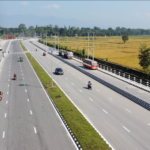Parts of India and Pakistan have been grappling with record-breaking heat that have drawn global headlines. On May 24, temperature in the streets of New Delhi, one of the hottest cities on Earth, soared to record highs. The India Meteorological Department reported a staggering temperature of 52.3 degrees Celsius (that’s approximately 126 degrees Fahrenheit) in Mungeshpur, a suburb of New Delhi. This figure is 6 degrees Fahrenheit more than the previous highest temperature recorded in the region during the similar heatwaves in 2022. The heatwaves have not subsided yet, and reports suggest that over 50 people have succumbed to the extreme heat so far.
While every loss of life is a profound tragedy, the reported death toll is relatively low considering the severity and duration of the heatwaves the region has experienced. Despite the challenging living conditions, including widespread poverty, this relatively low mortality rate is striking, especially when compared to the significant death tolls from less intense heatwaves in Europe during 2022 and 2023. For reference, Europe reported over 70,000 heat-related deaths in 2022 and over 60,000 in 2023.
This big difference really makes you wonder about the accuracy of the data or whether deaths are being incorrectly attributed to other causes in the subcontinent. Or, it could be that people in India or Pakistan have become more immune to the extreme heat than those in Europe. But these inconsistencies make it really challenging to fully comprehend to what extent these heatwaves are affecting the subcontinent. Since the heatwaves are becoming frequent and more and more severe, we definitely need more research to get to the bottom of this.
Furthermore, this issue is not unique to India and Pakistan; severe heatwaves affect the entire region. Nepal’s Terai plains, have faced temperatures often exceeding 40 degrees Celsius – particularly between June and July in recent years. Similarly, Bangladesh set a new heatwave record in April this year with 24 days of extreme heat, surpassing the previous record of 23 days in 2019. While Delhi and Dhaka suffer from extreme heat and high humidity, making conditions almost unbearable, Nepal’s plains experiences scorching temperatures but much drier conditions compared to Delhi creating different but equally severe health risks.
Similar to the catastrophic heatwaves in India and Pakistan, the United States is also bracing for a season of extreme heat. Regions traditionally experiencing temperate summers, like New Mexico and Utah, now face a 60%-70% chance of above-normal temperatures. However, the tale of two heatwaves is shaped by the plot difference regarding underlying climate conditions between Indian humidity and western dryness.
Unlike the dry heatwaves experienced in Europe and the United States, the Indian subcontinent suffers a deadly combination of high temperatures and super high humidity. This mix, measured by the ‘wet-bulb temperature,’ is dangerous to human survival — especially in populated urban cities like those in India. When the ‘wet-bulb’ temperature reaches or exceeds 35°C (that’s 95°F), it becomes critically dangerous as the body struggles to regulate its internal temperature, potentially leading to fatal heat strokes. Continuous exposure to such high temperatures prevents the human body from recuperating, significantly increasing the risk of other heat-related illnesses and even deaths. These conditions are silent killers that pose a widespread threat to millions — especially the working class living in extreme poverty. Here is an interesting Nature article on why humidity is key in understanding heatwaves, comparing examples from Europe, the US, and India-Pakistan.
At heart of the problem lies the recognition that these numbers are not mere spikes on a thermometer. Rather in places like India, Pakistan and Bangladesh where over a billion people face these extreme conditions, heatwaves represent a pervasive and immediate threat, especially to the millions in the working class who live in dire poverty. Moreover, the state of health systems in the region — often underfunded and overwhelmed — portends a grim future as heatwaves become more severe.
In addition to the health concerns, the intense heat has other environmental impacts, including the depletion of soil moisture. Healthy soil works as a natural coolant. During prolonged heatwaves, it progressively loses moisture over the time, exacerbating the already harsher conditions — particularly in rural and agricultural areas. This drying of the soil creates a worsening feedback loop that not only intensifies climate warming but also exacerbates drought conditions. With the frequency of severe heatwaves increasing each year in the region and conditions worsening, key questions arise: How can the region prevent further fatalities and damage? How will millions of poor adapt to these cascading effects?
In developed nations, such as those in the EU and the US, widespread access to air conditioning, advanced healthcare, and effective emergency response strategies mitigate the impact of heatwaves to a larger extent. The infrastructure in these countries is better designed to withstand extreme temperatures. In cities like Chicago, urban design features such as reflective materials and green spaces combat heat effectively. In stark contrast, India faces severe challenges. Urban slums in Indian cities lack adequate cooling, and their dense populations worsen the urban heat island effect. And low wage workers often endure intense heat in physically demanding jobs, and its energy infrastructure cannot support widespread air conditioning — unlike resource-rich countries in the west.
This global rise in heatwaves highlights a disturbing trend intensified by climate change, affecting nations rich and poor. While this calls for an urgent reassessment of how nations, from the US to India, prepare for and respond to the challenges posed by these new climate realities, the impact is disproportionately severe in the subcontinent, where things like high humidity, dense cities, and rampant poverty meet a shortage of good infrastructure and emergency support. In the US, states like Washington and Colorado have taken proactive steps by enacting laws to protect outdoor workers from the dangers of extreme heat, a measure yet to be universally adopted in India. These legislative actions underscore the urgent need for policies that prioritize human safety amidst rising temperatures.
As the world’s third-largest emitter of greenhouse gases, India faces a critical dual challenge: reducing emissions and adapting to escalating heatwave severity. Dealing with these challenges in tandem is increasingly critical. As the region braces for more frequent and intense heatwaves, proactive local adaptation strategies become not just necessary but urgent, serving as a frontline defense to save millions from the ravages of these extreme heatwaves.
Bibek Raj Kandel is a Senior Fellow at Nepal Economic Forum and an expert in energy and climate, with experience across Asia, Africa, and the Pacific Islands.





